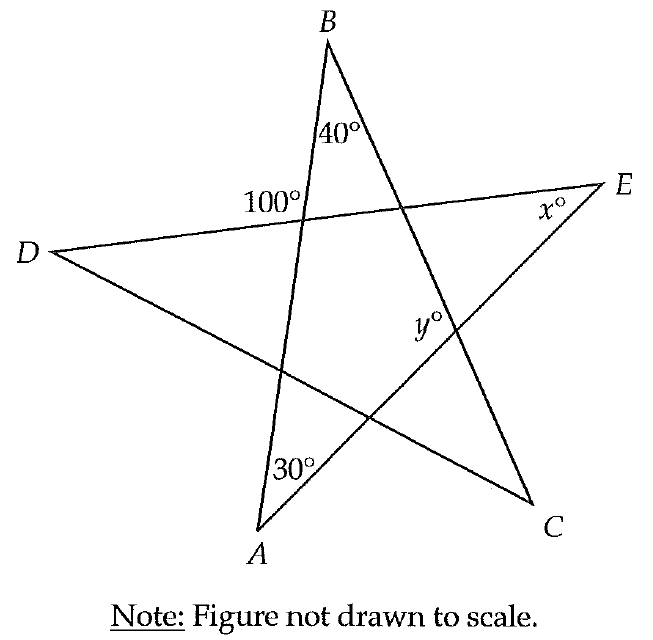SOLVING SYSTEM OF EQUATIONS BY SUBSTITUTION WORKSHEET
Problem 1 :
Solve for x and y :
x + y = 5
2x + 3y = 5
Problem 2 :
Solve for x and y :
2x + 5y = 12
4x - y = 2
Problem 3 :
Solve for x and y :
x + y - 4 = 0
2x - 3y - 18 = 0
Problem 4 :
Solve for x and y :
3x + 5y = -2
2x - y = 3
Problem 5 :
If there is a total of 9 bicycles and unicycles and there are 13 wheels in total, find the number of bicycles and unicycles.

1. Answer :
x + y = 5 ----(1)
2x + 3y = 5 ----(2)
Step 1 :
Solve (1) for y.
x + y = 5
Subtract x from each side.
y = 5 - x ----(3)
Step 2 :
Substitute (5 - x) for y into (2).
2x + 3(5 - x) = 5
2x + 15 - 3x = 5
15 - x = 5
Subtract 15 from each side.
-x = -10
Multiply each side by (-1).
x = 10
Step 3 :
Substitute 10 for x into (3).
y = 5 - 10
y = -5
Therefore, the solution is
(x, y) = (10, -5)
2. Answer :
2x + 5y = 12 -----(1)
4x - y = 2 -----(2)
Step 1 :
Solve (2) for y.
4x - y = 2
Subtract 4x from each side.
-y = 2 - 4x
Multiply each side by (-1).
y = 4x - 2 -----(3)
Step 2 :
Substitute (4x - 2) for y into (1).
2x + 5(4x - 2) = 12
2x + 20x - 10 = 12
22x - 10 = 12
Add 10 to each side.
22x = 22
Divide each side by 22.
x = 1
Step 3 :
Substitute 1 for x into (3).
y = 4(1) - 2
y = 4 - 2
y = 2
Therefore, the solution is
(x, y) = (1, 2)
3. Answer :
x + y - 4 = 0 ----(1)
2x - 3y - 18 = 0 ----(2)
Step 1 :
Solve (1) for x.
x + y - 4 = 0
Add 4 to each side.
x + y = 4
Subtract y from each side.
x = 4 - y ----(3)
Step 2 :
Substitute (4 - y) for x into (2).
2(4 - y) - 3y - 18 = 0
8 - 2y - 3y - 18 = 0
-5y - 10 = 0
Add 10 to each side.
-5y = 10
Divide each side by -5.
y = -2
Step 3 :
Substitute (-2) for y into (3).
x = 4 - (-2)
x = 4 + 2
x = 6
Therefore, the solution is
(x, y) = (6, -2)
4. Answer :
3x + 5y = -2 ----(1)
2x - y = 3 ----(2)
Step 1 :
Solve (2) for y.
2x - y = 3
Subtract 2x from each side.
-y = 3 - 2x
Multiply each side by (-1).
y = 2x - 3 ----(3)
Step 2 :
Substitute (2x - 3) for x into (1).
(2)----> 3x + 5(2x - 3) = -2
3x + 10x - 15 = -2
13x - 15 = -2
Add 15 to each side.
13x = 13
Divide each side by 13.
x = 1
Step 3 :
Substitute 1 for x into (3).
y = 2(1) - 3
y = 2 - 3
y = -1
Therefore, the solution is
(x, y) = (1, -1)
5. Answer :
Let x be the number of bicycles and y be the number of unicycles.
Given : There is a total of 9 bicycles and unicycles.
x + y = 9 ----(1)
Given : There are 13 wheels in total.
2x + y = 13 ----(2)
Step 1 :
Solve (1) for x.
x + y = 9
Subtract y from each side.
x = 9 - y ----(3)
Step 2 :
Substitute (9 - y) for x into (2).
2(9 - y) + y = 13
18 - 2y + y = 13
18 - y = 13
Subtract 13 from each side.
-y = -5
Multiply each side by (-1).
y = 5
Step 3 :
Substitute 5 for y into (3).
x = 9 - 5
x = 4
The solution is
(x, y) = (5, 4)
So, there are 5 bicycles and 4 unicycles.
Kindly mail your feedback to v4formath@gmail.com
We always appreciate your feedback.
©All rights reserved. onlinemath4all.com
Recent Articles
-
Digital SAT Math Problems and Solutions (Part - 134)
Apr 02, 25 12:40 AM
Digital SAT Math Problems and Solutions (Part - 134) -
SAT Math Resources (Videos, Concepts, Worksheets and More)
Apr 02, 25 12:35 AM
SAT Math Resources (Videos, Concepts, Worksheets and More) -
Digital SAT Math Problems and Solutions (Part 135)
Apr 02, 25 12:32 AM
Digital SAT Math Problems and Solutions (Part 135)

